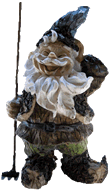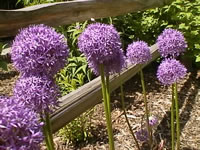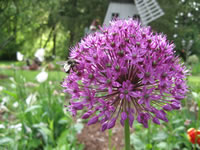Planting, Growing and Caring for Flowering OnionsAllium species |
||||||||
|
There are over seven hundred known species of Alliums. The best known members of the Allium genus are onions, garlic, chives, leeks and shallots. The genus contains many species that are well suited for your flower gardens as well. These Alliums are commonly known as Flowering Onions. Flowering Onions are bulb type plants with green, grass-like foliage. They produce 1-6 ft. hollow, leafless stems that are topped with 1"-5" flower clusters, called umbrels, that can contain as many as 100 tiny, star shaped flowers.
Persian Onions, Allium aflatunense, are hardy in USDA zones 4-8.
Early summer bloomer with 4"-4½", round clustered umbrels of 50 , rose-purple flowers on 2-3 foot stems.
Giant Alliums, Allium giganteum, are hardy in USDA zones 6-10. Summer bloomer with 4"-6", dense, round umbrels with up to 100 star shaped, violet to deep purple flowers on 4-6 foot stalks. 'White Giant' hybrid bears white flowers. Coast Onions, Allium dichlamydeum, are California natives that are hardy in USDA zones 8-9. Summer bloomer with loose, upright umbrels with 10-15 bell shaped, magenta colored flowers on stout 10-"-12" stems. Allium senescens is a dwarf species that is hardy in USDA zones 5-9. Late summer bloomer with strap-like foliage that is evergreen to 25°. 1" domed shaped umbrels with 20-30 tiny, bright pink flowers on 6-"-12" mounding clumps. Three Cornered Leeks, Allium triquetrum, are immediatly recognizable by their triangular flower stems. They are hardy in USDA zones 7-10. Late spring to early summer bloomer with 10"-18" stems topped with small, loose umbrels of 5-15 nodding, bell shaped, lightly scented white flowers on quick spreading mounds. How to Propagate Flowering Onion Plants
|
||||||||
Search The Garden Helper:


